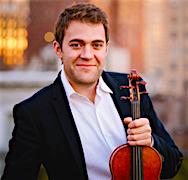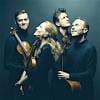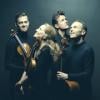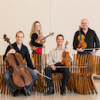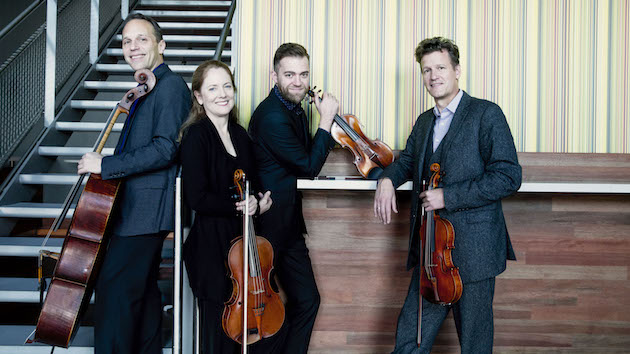
Debut concerts under the umbrella of the newly formed Bay Area Music Consortium this week and next auger the advantages to artists and audiences of uniting the goals and resources of the four participants: the Gold Coast Chamber Players, the Noe Valley Chamber Music series, Berkeley Chamber Performances, and the Mill Valley Chamber Music Society.
The featured artists are the St. Lawrence String Quartet, whose violinist, Owen Dalby, is co-artistic director (with his wife, violist Meena Bhasin) of the Noe Valley series. The four venues are the home bases of the Consortium participants, and the dates are the Lafayette Library on Feb. 9, the Noe Valley Ministry on Feb. 10, the Berkeley City Club on Feb. 12, and Mt. Tamalpais United Methodist Church in Mill Valley, on Feb. 17.
The Consortium’s mission is to enhance the local appeal of chamber music by combining curatorial input, block-booking artists local, national, and international, and cross-promoting each new series of concerts. Dalby, speaking at a coffeehouse near his San Francisco home, points out that this mission parallels that of the St. Lawrence in its role as ensemble-in-residence at Stanford University, “whether it’s a matter of dealing with dwindling audiences or with the feeling that chamber music is isolated.”
The isolation, notes Dalby, has been aggravated in the Bay Area by “separate audiences that don’t tend to cross bridges,” prompting the Consortium to bring the music to these audiences rather than expecting to draw dispersed audiences to the same music venues. “The financial advantage,” he continues, “is that we can ban together and block-book, bringing in performers that no individual presenter could bring. And we [collectively] have a read on great artists who are going to bring compelling and often thematic programs that other presenters in the Bay Area might not take a risk on.”
Each of the current Consortium members, Dalby points out, “has its own longtime subscriber base, and they’re all tried and true.” The Consortium concerts will be the only Bay Area public performances by the St. Lawrence this season, “and I’m especially excited for the Berkeley City Club, because I was a Berkeley kid, and it’s near and dear.”
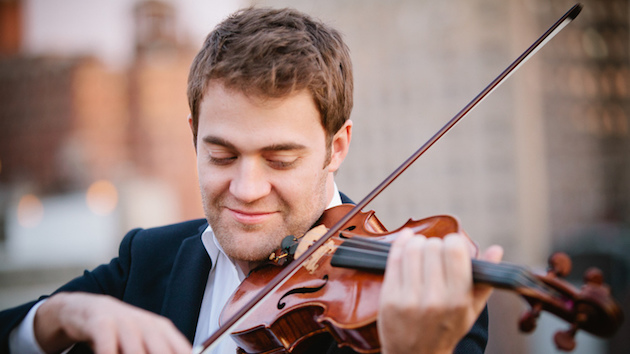
The 34-year-old violinist was educated at the Crowden School alongside John Adams’s children Emily and Sam, where he knew composer John as “the funny ski-trip dad.” After private study with school founder and violinist Anne Crowden, Dalby performed with the San Francisco Youth Orchestra and went on to Yale and to the precursor of the Ensemble Connect program at Carnegie Hall and Juilliard. With the Decoda ensemble, he participated in outreach programs such as bringing music into prisons. A call from St. Lawrence violinist Geoff Nuttall brought Dalby and his new bride back to Northern California, where his parents and siblings still live and the Adams family had reconvened. (The St. Lawrence performed a program of quartets by John and Sam Adams at UC Berkeley a year ago.)
The program of the Consortium’s initial outing accords with the spirit of the collaborators. “You could say that communion is the general theme,” says Dalby. “The Haydn Op. 20 Quartet, which we’ve made a specialty of, is the oldest of the four pieces. [The St. Lawrence’s recording of it will be released by eaSonus later this year.] Every passing moment has something gobsmackingly beautiful and unexpected, and it’s an example of the communion of four people interacting on equal footing for the first time. We’re doing the No. 4 [in this program], and it has this minuet, in the third movement, Allegretto alla zingarese, which is in Hungarian gypsy style. But Hadyn has a glint in his eye, because it’s impossible to dance a minuet to. This is then the inspiration for Jonathan Berger’s Tango alla Zingarese” in a West Coast premiere by this Stanford-based colleague of the St. Lawrence’s. As with the Haydn, “it’s not so much a dance itself, it’s expectation denied, being wrong-footed in a kinetic, hilarious way.”
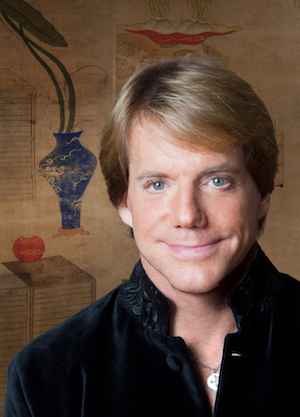
Dalby describes Beethoven’s “Heiliger Dankgesang,” from the composer’s String Quartet in A Minor, as “an organic outpouring, thanking god for recovering from a near-death [stomach] illness. The chorale is in F major with a Lydian tinge, with a B-natural instead of a B-flat, so that it’s got this expansive sound that points upward.” Osvaldo Golijov’s Dreams and Prayers of Isaac the Blind invokes “the best sort of concert experience, when performers and audiences and composer start to exist in this amazing acoustic space together, and commune with one another. With each piece of Golijov’s, he’s tapped into some deep river of communal psyche.” For the Consortium concerts, the St. Lawrence will be reunited for this piece with New York-based clarinetist Todd Palmer, who recorded it with them on EMI Records in 2002.
Musicologist Kai Christiansen will discuss the program with audiences at all four of the venues. The Consortium’s next season, assures Dalby, “is already in the works, but I can’t spill the beans on it yet. I’d just say: keep your eyes on the Grammys.”

